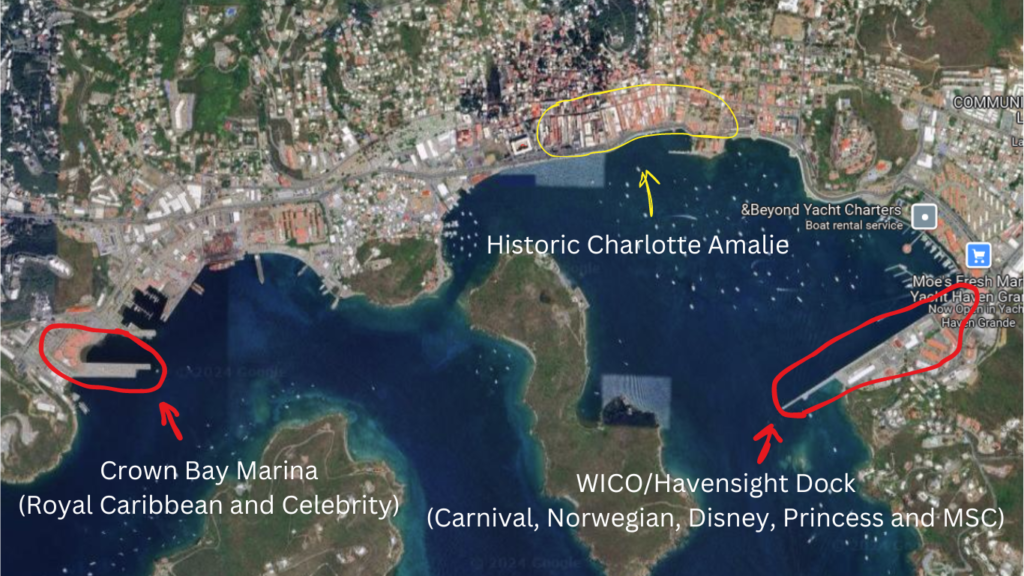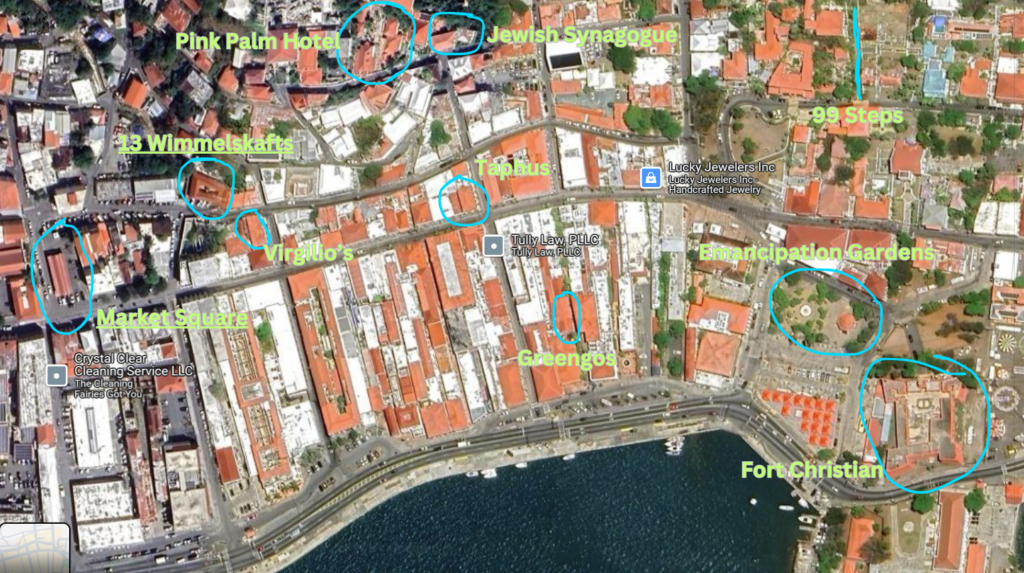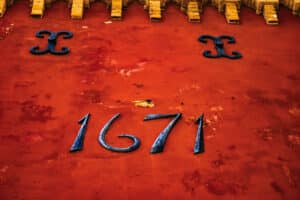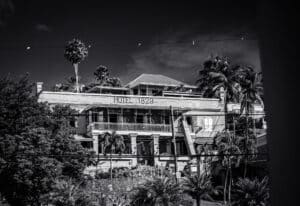Enjoy this free, self-guided walking tour in historic Charlotte Amalie in St. Thomas!
This tour is perfect if you are coming to St. Thomas on a cruise ship.
(If you are staying on island your best bet is to park at the Fort Christian Parking Lot – it’s on Google Maps. Or have your taxi driver drop you in front of Fort Christian.)
To begin your walking tour, your first order of business will be to get from your cruise ship to downtown Charlotte Amalie in St. Thomas (Charlotte Amalie is the heart of the island and a National Historic Landmark).
Below is a map with the location of the two cruise ship docks and Charlotte Amalie.
*Important Note: You are not allowed to walk from your ship to town. No matter how close it appears, the walk is noisy, hot, and without shade or bathrooms. If you want to enjoy this guided tour, you won’t want to spend the first 20 minutes of it walking in the Caribbean heat.

Below I have a suggested route/path for your walking adventure, but feel free to wander and take detours – Charlotte Amalie is a small town and everything is no more than 5-6 minutes away.
*I rated each stop or site for its historical significance and photographic potential. The rating for each stop is based entirely on my own, made up criteria. But I think they are pretty accurate.
Let’s start with the main sites for your tour.

Historical Sites on walking tour:
1. Fort Christian

Established: 1672 (construction began)
Admission: $10
Historical Significance Rating: 10/10
Photo Opportunities Rating: 10/10
Fort Christian is your first stop. The fort is one of the most recognizable and important sites on your tour. More than any other structure, Fort Christian provides a direct portal to the 1670s. The bones of the fort date back 350 years.
They charge a $10 admission fee to enter the fort, but once inside you’ll have extensive access to the rooms, halls and corners of this impressive building. There are a few exhibits.
Highlights:
1. You can see the governor’s quarters, the courthouse and where church services were held centuries ago. Fort Christian was the center of the universe for the tiny Danish colony into the 20th century.
2. The dungeon – a solitary cell for folks needing an extra level of punishment.
3. The catwalk around the top of the fort is pretty cool – you’ll get great views of downtown Charlotte Amalie. But what I like to do is imagine pirate ships entering the harbour. The early government was friendly to all sorts of awful folks. It’s well documented that the governors would party with unsavory gents and would launder their plunder.
For a more extensive dive into its history (but not too deep) you can read about Fort Christian here.
2. Emancipation Gardens
Established: 1848 (sorta)
Admission: Free
Historical Significance Rating: 9/10
Photo Opportunities Rating: 5/10
Just across the street from Fort Christian is a little town square. In 1848 it was announced that all slaves were free in the Danish West Indies (the Virgin Islands). Therefore, the park has incredible significance for the island and its people.
Imagine being a slave. The Danish king just issued a proclamation he’s going to free you in a decade. So for the next 10 years, hang tight, be patient and don’t die in the meantime! Needless to say, the enslaved folk weren’t thrilled with having to wait 10 years. So they rose up and demanded immediate freedom. The uprising convinced the governor in St. Croix to issue the proclamation immediately freeing all slaves.
The proclamation was issued on St. Croix. Now imagine someone had to write up the proclamation, get the document signed by the governor, put it on a boat, sail it 40 miles north to St. Thomas. Then you had to get the peoples of St. Thomas to gather in the town square for the big announcement.
Dude, I can’t imagine how hard they partied that day.
Highlights:
1. A statue of “The Conch Blower”. The statue commemorates the moment of emancipation. You can actually approach and stand right next to the statue. It’s simple but powerful.
2. A replica of the Liberty Bell sits in one corner of the gardens. Every state and territory was issued a bronze sculpture of the bell. If you visit this one you can save yourself a trip to Philadelphia.
3. A large tamarind tree sits in the corner across from the Grand Hotel and Post Office. If you come at the right time there are tons of tamarinds on the tree – help yourself to this island treat!
3. 99 Steps
Established: early 1700s
Admission: Free
Historical Significance Rating: 6/10
Photo Opportunities Rating: 6/10
At first glance 99 Steps is just a staircase. But with a little context, it is definitely worth a visit. St. Thomas quickly grew in the late 1600s because of its commercial importance in the region. Ships and colonists from all over the world passed through Charlotte Amalie harbour – French, African (both slaves and free), German, Dutch, English, Spanish and Danish to name a few.
The growing merchant class and government expanded the town up the surrounding hills. Standard streets were not feasible so they created step streets. So when you come upon a staircase in town it is actually a street. Homes and shops were built along these streets. 99 Steps is the most iconic and picturesque of our step streets.
Highlights:
1. A Good Life – as you ascend the step street you have to count your steps. If you do, you are assured a good life. Alternatively, if you fail to count correctly or skip a step…you have to go back down to the bottom and begin again.
2. The materials used for the steps were ballast in ships coming over from Denmark. Empty ships used ballast to keep them steady on the trip over. Once in St. Thomas they emptied their ballast to make room for tobacco, cotton and molasses. So you are stepping on some old stuff.
3. As you walk up the steps imagine all the elite of Danish society walking up these stairs multiple times a day. I’m guessing they had some firm glutes.
4. Hotel 1829

Established: 1829
Admission: Free
Historical Significance: 9/10
Photo Opportunities Rating: 9/10
Situated just down from 99 Steps is this jewel of a property. Currently being restored to its former glory you can stop in at the bar and enjoy a beautiful view of town. Almost every detail at Hotel 1829 is either original or old enough to feel like you have transported back in time.
5. Jewish Synagogue
Established: 1600s
Admission: Free
Historical Significance Rating: 8/10
Photo Opportunities Rating: 7/10
One of the oldest Synagogues in the New World. Jewish people were welcomed, or at least tolerated, almost from the very beginning of the Danish colony. Jewish money changers, bankers, and traders came over from neighboring islands to prop up the burgeoning settlement.
Highlights:
1. You’ll walk up a small, but intense little hill to reach the synagogue. Getting there is part of the fun though because of the beautiful architecture and quaint buildings you’ll see as your hamstrings burn.
2. The synagogue has a funky floor – the congregation and area of worship is covered in sand.
6. 13 Wimmelskafts & 3 Queens Distillery

Established: 1700s but was destroyed in a fire in the 1830s and rebuilt in its current form.
Admission: Free
Historical Significance Rating: 9/10
Photo Opportunties Rating: 9/10
This unassuming building was the former slave house and servants quarters for a string of wealthy merchants in town. From the street it looks small and unremarkable.
As you walk through the doors you’ll have to imagine that this little structure housed upwards of 10-15 people. The staff there is happy to give you a quick primer on how the slaves worked, lived, loved and played in such tight housing conditions.
It is one of the best preserved former slave quarters in the Caribbean and while they don’t have any slavery artifacts, they do have some interesting historical items not found anywhere else on island – old letters, maps and bric-a-brac from the island’s history.
Aside from the history of the building, the property is the home of 3 Queens Distillery. Enjoy a rum tasting and learn about the history and making of rum.
Highlights:
1. A brick double-oven dating back hundreds of years, a one-of-a-kind specimen still in use today.
2. The ceiling, for architectural/carpentry nerds, was built 200 years ago almost entirely with joinery and zero hardware. Mostly likely built by skilled slave carpenters trained by Italian artisans.
3. The back of the building is a tropical garden where the former inhabitants would have raised chickens, pigs and tended to a small garden. There are majestic palms and shaded areas to sit and relax. This little secret spot is unique in all of Charlotte Amalie.
4. Rum.
You can also check out this post: 8 Best Historical Sites in St. Thomas for some additional spots that are included on the map.
7. Market Square
Established: late 1600s
Admission: Free
Historical Significance Rating: 9/10
Photo Opportunities Rating: 4/10
This is the end of the line. Not much to see here other than a tip of the hat to all those that went and suffered before us.
The area was the main market for merchants of all kinds, including slave merchants. Today you won’t see much other than a plague with some information on it’s historical significance. It is worth a quick stop as it is not more than a couple hundred feet from the main section of town.
Bars and Restaurants in Charlotte Amalie for before, During or after your Walking Tour:
Greengos – you can grab Tex-Mex food here or a tequila shot. They also make a wonderful margarita.
Taphus – full bar with wide selection of beers and booze. A beautiful spot.
Johnny’s – a must-do for a drunkin’ milkshake. They have a walkup window if you want to grab your boozy milkshake and go. We love to drink and walk here in the islands. They also serve some local fried foods options that are quick and easy.
Virgilio’s – a wonderful sit-down, Italian restaurant. Super cozy and comfortable spot with excellent food. Love that A/C!
Side Street Pub – a perfect restaurant for ‘fast casual’. Sandwiches and tacos compliment their drink menu.
Pink Palm Hotel – an adults only boutique hotel and one of the absolute best places to enjoy a quiet drink or meal. No reservation required, just find their “almost secret” front door. It’s a few dozen feet from the Synagogue.
Hotel 1829 – a historic property that looks and feels like the Caribbean long past.
Some general information and advice for your self-Guided Tour:
1. Heat/Staying hydrated
St. Thomas is in the subtropics. Therefore it is typically in the mid-to-high 80s during the day all year. Please take the time to hydrate and bring water. There are shops along the way that sell water and other drinks, but always nice to bring your own.
During your walk you won’t find a lot of shade so assume you’ll be on your feet and in the sun when walking. There are plenty of shops if you need to step into some AC. It’s worth noting that 99 Steps is good to visit toward the start of your tour because that’s a lot of steps! Also, the Jewish Synagogue is on a bit of a hill which can also get the heart rate up. Other than 99 Steps and the Synagogue everything in town is flat and won’t be difficult to navigate.
2. Transportation
The cruise ship is overrun with taxis. Finding one will be easier than finding me at a beach with a drink on Sunday. Tell the taxi dispatch you want to go to “Fort Christian”. You’ll be looking at about $6 or $7.
For the return trip, taxi drivers will drive down Main Street in town and are always ready to talk you back to the ship. You can also walk over to the waterfront and find at least 638 taxis to choose from.
3. General history about Charlotte Amalie to make your walking adventure a bit more interesting
Charlotte Amalie was established by the Danish King Christian VI. The first settlers were mainly convicts and conscripted folks. They arrived in St. Thomas on May 25, 1672.
It didn’t take long for the settlement to grow as colonizers began arriving from other islands. The massive harbour was deep and well protected offering a perfect spot for ships to rest, regroup, repair and “rebeer”. By that I mean the town had a couple beer/rum houses for weary sailors.
During the 250 years of Danish rule St. Thomas was a trading post and mainly exported sugar cane, molasses and rum. One of its main imports was African slaves.
Slavery was abolished in 1848 but the town was made up of many freed slaves, and free persons of African decent before emancipation. The remaining population was a mishmash of merchants, laborers and farmers of European (aka “White) descent. Put all these different people together on an island with some booze and you get a lot of “mixing”. So the hues of islanders range from lightly tanned to a few shades short of black.
Religion had and still has a significant influence on the culture and life of Virgin Islands. The Danish Reformed Church, The Moravians, Lutherans and Catholics were some of the main religions. Jewish people also made up a pocket of the population.
St. Thomas is now a United States Territory and Virgin Islanders are US citizens. Charlotte Amalie and the larger island relies massively on tourism. Among its exports are beer, rum, vodka and coffee. But they are a tiny fraction compared to the tourists that travel from all over the US and world to this tiny island.
As far as culture, the island loves to celebrate Carnival each April. It’s basically one to two weeks of partying. Soca is the music of choice. And beaches are the pastime of all islanders.
(I would also recommend this 5 minute read: History of St. Thomas in 1,000 Words.)
If you prefer a guided walking tour that covers these spots and more try our Historic St. Thomas Walking Tour ($59) that includes water, rum punch, admission to Fort Christian and lots of great stories.
Conclusion:
Look beyond the jewelry shops and souvenir stores. Not that shopping is a bad thing, but don’t let them distract you from the incredible history and beauty of this old town. By walking the streets and alleys of St. Thomas you’ll hopefully find a deep appreciation for the island and will find some hidden gems along the way.
Now back to the ship!


